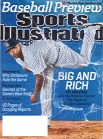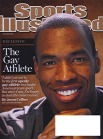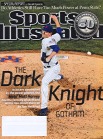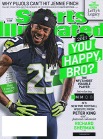Wait, I thought print journalism was dead
I get a lot of magazines in the mail. That probably makes me unusual in today’s “print is dead” world where a journalism degree is worthless without a concentration in food service. Some of these magazines are gifts, some are the result of impending airline mile expirations, some are misdelivered by the post office, and I don’t know how I got on Good Housekeeping’s mailing list. The one common thread is that I don’t pay for any of them.
Occasionally, I’ll find something in the pile that I would have actually considered paying for. Stephen Colbert’s issue of Newsweek (remember Newsweek?) is at the top of that list. Other times, there’s an article that stands out, like a short interview with Darryl Strawberry in another issue of Newsweek (I swear, this is a thing that used to exist). And sometimes I subscribe to something like The New York Observer just hoping to get an interesting Mets ad or two (and after a few Yankees ads and a full-page tasteful nude print, there actually were several large Mets ads). Mostly, it helps me to fill my recycle bin and earn a few more cents for my town to not spend on making my road look less like a post-apocalyptic hellscape.
Enter Sports Illustrated. Actually, it was more like “Enter code from a Coke bottle cap.” Because when I did just that, I got a special offer to get a 28-issue subscription to Sports Illustrated for only 95 Coca-Cola points. What a bargain! With a cash value of “250 points will get you one coupon good for a free 12-pack of soda”, that’s actually cheaper than the “92% off the cover price!” deals they offer all the time. The only catch was that I had to decide immediately. Was it worth using up a quarter of my points for another magazine? Well, that’s the question I’ve now set out to answer.
General Content
As the name implies, Sports Illustrated covers a lot of sports and has a lot of pictures. I, on the other hand, only have an interest in baseball and don’t really care about pictures unless they have something to do with the Mets. Given the team’s struggles, that could limit the amount of applicable content. Starting my subscription at the start of the year didn’t help matters any, but it could not be avoided. The deal expired at the end of 2012, so I had to activate my 6-month subscription deep in the football, basketball, and (in theory) hockey seasons. At least I should be able to get most of the way to the All-Star break, not that I’ll miss any important content by waiting to the last minute. And then R.A. Dickey appeared on the cover. There were no baseball covers between October 1, 2012 and February 25, 2013, but there’s Dickey on December 17, 2012.
The first six months of the year aren’t very good for baseball coverage. With playoffs in football, basketball, and hockey on top of college finals, there’s not much room left for stories about spring training and small sample size successes that will fade over a 162-game season. Overall, the amount of baseball coverage wasn’t even worth the time it took to flip through many of these issues. Baseball content started to take over once basketball and Hockey wrapped up in June, but then football was back in the picture by the end of July, well after my subscription was supposed to have expired.
Specific Issues
The typical issue of SI went through this life cycle: appear in my mailbox, get flipped through for a minute to find anything of interest, retire to the recycle bin and await curbside pickup. Some didn’t even get that much use if I got the electronic version first (the print version won the race a few times, as unlikely as that sounds). A few issues managed to avoid this fate, so that must say something about their value.
15 February 2013 – Swimsuit 2013
 OK, I have a confession to make – I haven’t even opened this issue. It sat in my mail pile for a few weeks and then went into a binder sleeve. A lot of effort went into making this issue, and I’m not talking about the numerous pictures of scantily-clad ladies that I have been told can be found inside. This is a heavy-duty glossy magazine that is clearly meant to be treasured for many years and passed on to first-born children when they are of age. I can’t bring myself to toss something like that into the recycling bin. As for the content, it seems to be a bit of an anachronism straight out of the early ’60s.
OK, I have a confession to make – I haven’t even opened this issue. It sat in my mail pile for a few weeks and then went into a binder sleeve. A lot of effort went into making this issue, and I’m not talking about the numerous pictures of scantily-clad ladies that I have been told can be found inside. This is a heavy-duty glossy magazine that is clearly meant to be treasured for many years and passed on to first-born children when they are of age. I can’t bring myself to toss something like that into the recycling bin. As for the content, it seems to be a bit of an anachronism straight out of the early ’60s.
1 April 2013 – The Best Player You Never Saw
 The focus of this issue is the start of the 2013 baseball season, but the big draw is the story about Mets prospect Brian Cole. I wrote about Cole’s cards after seeing a preview of this article. As it turned out, my look at Brian Cole’s brief baseball card history was one of this site’s biggest draws this year, largely because people weren’t sure if the story was real or yet another April Fool’s joke about a too-good-to-be-true Mets prospect. Unlike the story of Sidd Finch though, this April 1 article was about a genuine tragedy.
The focus of this issue is the start of the 2013 baseball season, but the big draw is the story about Mets prospect Brian Cole. I wrote about Cole’s cards after seeing a preview of this article. As it turned out, my look at Brian Cole’s brief baseball card history was one of this site’s biggest draws this year, largely because people weren’t sure if the story was real or yet another April Fool’s joke about a too-good-to-be-true Mets prospect. Unlike the story of Sidd Finch though, this April 1 article was about a genuine tragedy.
22 April 2013 – Boston
 This one became buried in a pile of papers for reasons unrelated to its contents, so it was a bit out of date when I realized that it was still here. I’m not sure why I held on to it; I haven’t even read it. After being bombarded by the media coverage of the bombing and subsequent manhunt, I’m not sure there’s anything to be gained from a few more stories and pictures. Still, this seems too significant to dispose of.
This one became buried in a pile of papers for reasons unrelated to its contents, so it was a bit out of date when I realized that it was still here. I’m not sure why I held on to it; I haven’t even read it. After being bombarded by the media coverage of the bombing and subsequent manhunt, I’m not sure there’s anything to be gained from a few more stories and pictures. Still, this seems too significant to dispose of.
6 May 2013 – The Gay Athlete
 This one is just full of contradictions. On the one hand, the story of the first American professional athlete in one of the major sports to come out as homosexual is very well-written and compelling. On the other hand, why should this even be newsworthy in this day and age? It turns out that the story behind the story is what is most significant here – that, in 2013, American sports are one of the last major institutions to face the issue of how its homosexual participants are treated. This shouldn’t be a big deal, but for some reason, we’re only just starting to have the conversation, like parents sitting down with their middle-aged kids to discuss the birds and the bees. The rest of the world is getting all of this sorted out, why are sports only getting started on recognizing that homosexual athletes exist?
This one is just full of contradictions. On the one hand, the story of the first American professional athlete in one of the major sports to come out as homosexual is very well-written and compelling. On the other hand, why should this even be newsworthy in this day and age? It turns out that the story behind the story is what is most significant here – that, in 2013, American sports are one of the last major institutions to face the issue of how its homosexual participants are treated. This shouldn’t be a big deal, but for some reason, we’re only just starting to have the conversation, like parents sitting down with their middle-aged kids to discuss the birds and the bees. The rest of the world is getting all of this sorted out, why are sports only getting started on recognizing that homosexual athletes exist?
20 May 2013 – The Dark Knight of Gotham
 This is the real prize from my subscription. Matt Harvey in full (clothed) glory on the cover. Even better, this arrived when my subscription was winding down, so it came in a “Last Chance” renewal cover, keeping Harvey pristine underneath. This was worth 95 Coke points and then some.
This is the real prize from my subscription. Matt Harvey in full (clothed) glory on the cover. Even better, this arrived when my subscription was winding down, so it came in a “Last Chance” renewal cover, keeping Harvey pristine underneath. This was worth 95 Coke points and then some.
29 July 2013 – Why Pujols can’t hit Jennie Finch
 My 28th issue arrived on July 8. So why was I still getting the magazine on July 29? I have no idea, but I was glad I did. Inside is an excerpt from a book about how athletes become as good as they are. As it turns out, the discussion about how baseball players are able to hit a ball was relevant to a post I was working on about photographing baseballs at home plate.
My 28th issue arrived on July 8. So why was I still getting the magazine on July 29? I have no idea, but I was glad I did. Inside is an excerpt from a book about how athletes become as good as they are. As it turns out, the discussion about how baseball players are able to hit a ball was relevant to a post I was working on about photographing baseballs at home plate.
And that’s about it. I received the next issue (number 31 of 28) electronically and then my expired subscription finally expired. So what’s the verdict? Well, the 95 Coke point price was right, but I doubt I could be persuaded to part with the 400 or so points a 28-issue subscription normally costs. As for cash, forget it, I can read most of this online. Even on the off chance that I wanted an issue for the cover, paying full newsstand price (assuming that newsstands still exist and I can find one) would get me a clean copy. For free, it’s a great deal. Otherwise, these issues have issues.
The Good
Writing
As noted in the issue discussion above, there are several very good articles in there, some that aren’t fully available online. Unfortunately, there are maybe two from these seven months that I would consider paying for. That’s not enough to justify a subscription.
Mobile Support
Being able to download and browse an entire issue on my phone before the print version arrived was very convenient. Unfortunately, sometimes the print version arrived first. That really shouldn’t happen, unless the electrons are stuck in traffic or something.
The Bad
Mobile Support
Remember what I just said? Well, while the mobile experience was great when it was working, it would frequently have authentication errors that required signing out or even reinstalling the software. I also did not like the notifications it would push, though I suppose that could be turned off somewhere.
Content Diversity
I would be fine with nothing but baseball coverage, but this is a general sports magazine, so I can live with a variety of coverage. Unfortunately, that variety is largely limited to football, basketball, hockey, and baseball. I have no interest in the first three, so many issues had absolutely nothing of interest to me. What would be of interest? No, not soccer, golf, tennis, etc. It’s not an Olympic year, so that’s out. How about some coverage of sporting events I don’t know much about? MMA is getting some coverage, so that’s a start. There are plenty of fast-growing athletic competitions out there that may not be as polished and commercial as the big four sports, but that’s just what makes them interesting. Roller derby is making a big comeback as a serious sport with a sense of humor. Obstacle courses are growing in popularity; American Ninja Warrior is getting big ratings on NBC (though it is classified as non-sports for some reason) and even Citi Field hosted an obstacle course race this year. There’s a lot more out there than will fit in your fantasy football draft or NCAA bracket, but there isn’t room for it in SI.
The Ugly
Advertising
Ads are a necessary evil in media, but something seems a bit wrong with the ads in SI. Some make sense, like athletic clothing, sports drinks, personal hygiene products, media services, etc. Cars, travel, financial services, watches, electronics, and other luxury goods are also reasonable. Snacks and fast food, well, I guess you need something to munch on when watching the game on your tablet (though I’m not sure what’s going on in some of those peanut ads). Then we get to the hard stuff: viagra, alcohol, and cigarettes. I’ll admit, I was a bit surprised to see cigarette ads in this magazine, especially since they seem to be clustered two or three to an issue when they do appear. Back in the ’80s, cigarette advertising was everywhere. Today, it has largely vanished, or so I had thought. Some of these issues brought back memories of old issues of TV Guide, mainly because I think they’re still using some of the same ads. Now, I’m not advocating legislating away this type of advertising, but I would think that Sports Illustrated would want to stay away from drugs given the countless high-profile examples of athletes abusing even legal drugs and the message this sends to kids. It’s not like this is an adult magazine.
Women
Or is it? Back to the swimsuit issue, something seems a bit off with that. I don’t have a problem with the issue itself, and you can always opt out if you would rather have an extra non-swimsuit issue instead, but why is it there? Where’s the relevance to sports? And why is it only women in (or out of) swimsuits? ESPN Magazine has its annual body issue, but it addresses both of those issues by featuring male and female athletes, not exclusively female models. There are some great stories (in the digital edition at least) about the locations and the photography, but I don’t see the connection to the magazine’s core subject matter, unless that connection is supposed to be what its subscribers like to see. And I’m not sure that holds up anymore.
A 1997 SF Gate article puts the percentage of female Sports Illustrated subscribers at 14%. The most recent numbers I’ve found put that number at 23%. Anyone looking at those numbers should be able to tell two things: the number is going up (though two data points are far from conclusive) and there’s a big untapped market out there. You’re not going to have much luck tapping into that market though when your biggest issue of the year is something that a teenage boy would hide under his bed.
Markets are what they are though, so 23% might be the right balance for the content type, swimsuits or no. After all, that’s about what the female enrollment at my college peaked at, despite continued efforts to attract female students. Sometimes the root causes are greater than any one institution. It isn’t fair to hold SI responsible for who does or does not choose to subscribe to their magazine.
But it is fair to criticize the content they choose to publish. And that’s where, in addition to any sports behind the big four, professional female athletes come up short inside SI’s pages. Open up any issue and you’ll probably be more likely to find female athletes in the ads than in any of the feature articles (I haven’t conducted the study, but someone looking for a school project might want to try that one out). I flipped through the five regular issues mentioned above and found just four articles with more than half a page about female athletes. One that caught my eye was a short interview with Lexi Thompson that I recognized at the time as one of the rare instances where a professional female athlete was featured in the magazine. Then I noticed that it was sponsored by McDonald’s, complete with a full-page ad on the facing page.
There is a tremendous opportunity to improve the coverage of female athletes not just for the benefit of female readers but for all readers. If there is little interest among the male readers, how much of that is simply because there is no coverage? I had no idea that UFC was against creating a women’s division until I read about how Ronda Rousey’s dominance in the sport demonstrated that there was value in accepting female fighters. I hadn’t even heard of Ronda Rousey before. How many great stories are being overlooked because of the conventional wisdom that readers aren’t interested in stories about female athletes?
The Verdict
Well, enough of that, I didn’t intend to go so long on one topic. Let’s just say that Sports Illustrated and I have parted ways and leave it at that. Now, if you’ll excuse me, I have to get caught up on American Ninja Warrior. It sure beats football.
Comments are closed.